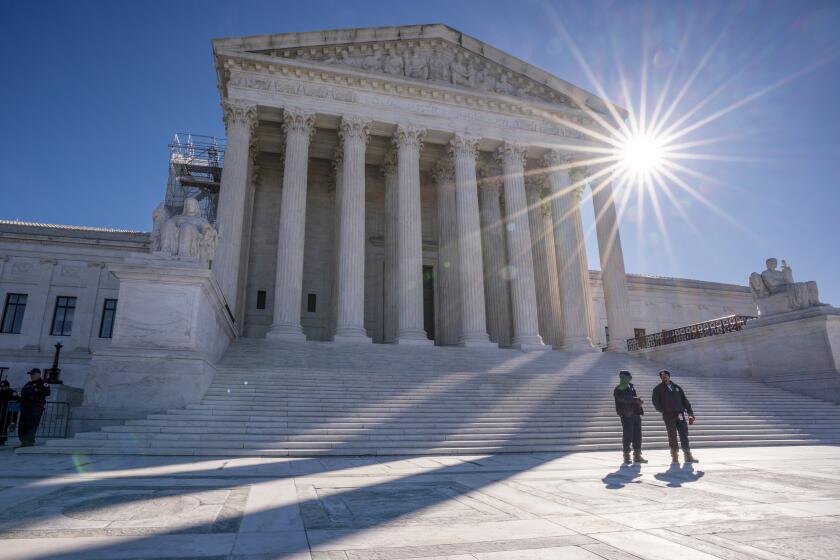
- Share via
The NBA draft combine concludes this weekend, and the draft is next month. However, before I dive into what kind of player the Los Angeles Lakers should pursue, I need to remind you of three significant economic shifts.
The first began in 1994 when Glenn “Big Dog” Robinson asked the Milwaukee Bucks for a $100-million contract after the team made him the No. 1 pick. Robinson eventually signed a 10-year, $68-million contract (the richest ever for a rookie), but the following year the league said goodbye to open-ended contracts for rookies. Today rookie deals are four years max.
Next, in 2006, the NBA changed eligibility rules requiring players to be at least 19 or one year removed from high school before entering the draft. This was because of the glut of high school phenoms who turned into pro duds.
And finally, in July 2021, the NCAA’s “name, image, likeness” policy went into effect. That means any senior in this year’s draft is part of the first full class of ball players who could monetize their entire college playing career.
All of which affects the answer to the pressing question: What kind of player should the Lakers pursue in next month’s draft?
The kind who had access to excess on a college campus for four years and proved they can handle the temptations that money and fame can bring. The kind that already had opportunities to make emotional or childish mistakes on the court or perhaps in a social media post and learned from them. The kind of player who didn’t get a real senior year in high school but made the best out of the cards they were dealt. Resiliency isn’t something that can be measured at the combine, which is ironic because without it, all the measurable qualities add up to nothing.
The league’s economic shifts made a “high ceiling” — meaning a lot of potential, but not a proven track record — the most sought-after quality in the NBA draft. As a result, players who can legally drink fell out of favor with scouts.
Consider, Michael Jordan was drafted in 1984 at the age of 21. At the time he was a relative youngster: The average age in the draft was 22.3. Before the eligibility rule change, Kobe Bryant was drafted at 17, and the average age had dipped to 22. When Lebron James was 18 in 2003, the average was 21.5. Last year the average was down to 20.
How has this affected the college game? In 2012, Kentucky won the NCAA title with a roster that was about 19.7 years old. In 2021, Baylor University won with players who averaged 22.3 in age.
While the Lakers roster is in desperate need of a big man — something that was made painfully clear in this year’s first-round playoffs loss — they likely won’t find the next Shaq with their No. 55 pick. But they could find the next Austin Reaves, who went undrafted as a 23-year-old senior in 2021.
That’s not to say youth isn’t a good thing. Only that with the advancement of technology and nutrition, “youth” has been greatly extended for professional athletes. Players in their late 20s are likely to still be in their prime performance years, not aging out. And LeBron James and the NHL’s Alex Ovechkin aren’t the only 40-year-old world-class examples to point to. Olympic skier Lindsey Vonn came out of retirement last fall and at 40 placed second in an event in March. What was considered old for an athlete when Jordan was drafted is not applicable today.
My hope is the Lakers comb through the entire NCAA spectrum and draft a 24-year-old college graduate who has NIL money in the bank and a good head on his shoulders. Critics of NIL complain that the new system makes it hard to build a good college program because players are constantly chasing money and have no team loyalty. I say it’s better to learn the lessons that can come from that while on a college campus than in the higher-stakes world of pro sports.
Back in the day, talented but raw college players felt pressured to earn money and would enter the league too early. Sometimes it was to protect their prospects of being drafted based on potential, before they had enough of a record that they would be judged on their accomplishments instead. Now, in the era of NIL cash and transferring among colleges, a promising 18-year-old can make a case to finish his degree before trying to go pro — maturing as a player, a student and a businessman without giving up his dream of being in the NBA.
No doubt the Lakers need a big man.
If they hold on to the pick, they should be sure to draft a grown-up as well.
More to Read
A cure for the common opinion
Get thought-provoking perspectives with our weekly newsletter.
You may occasionally receive promotional content from the Los Angeles Times.






